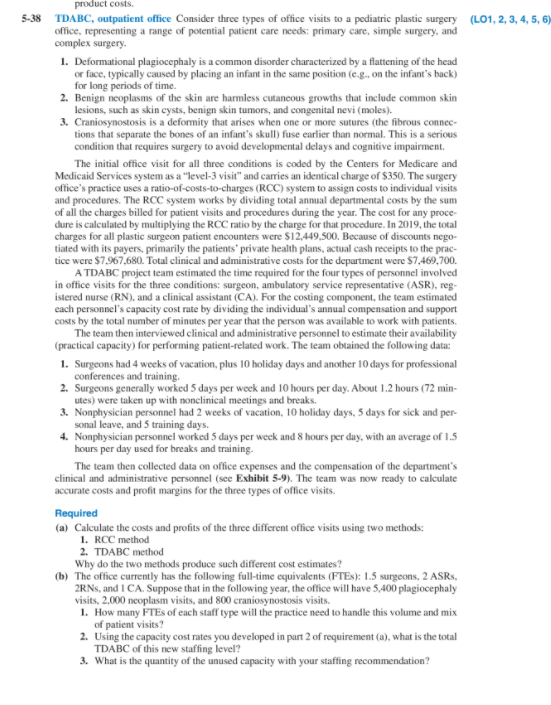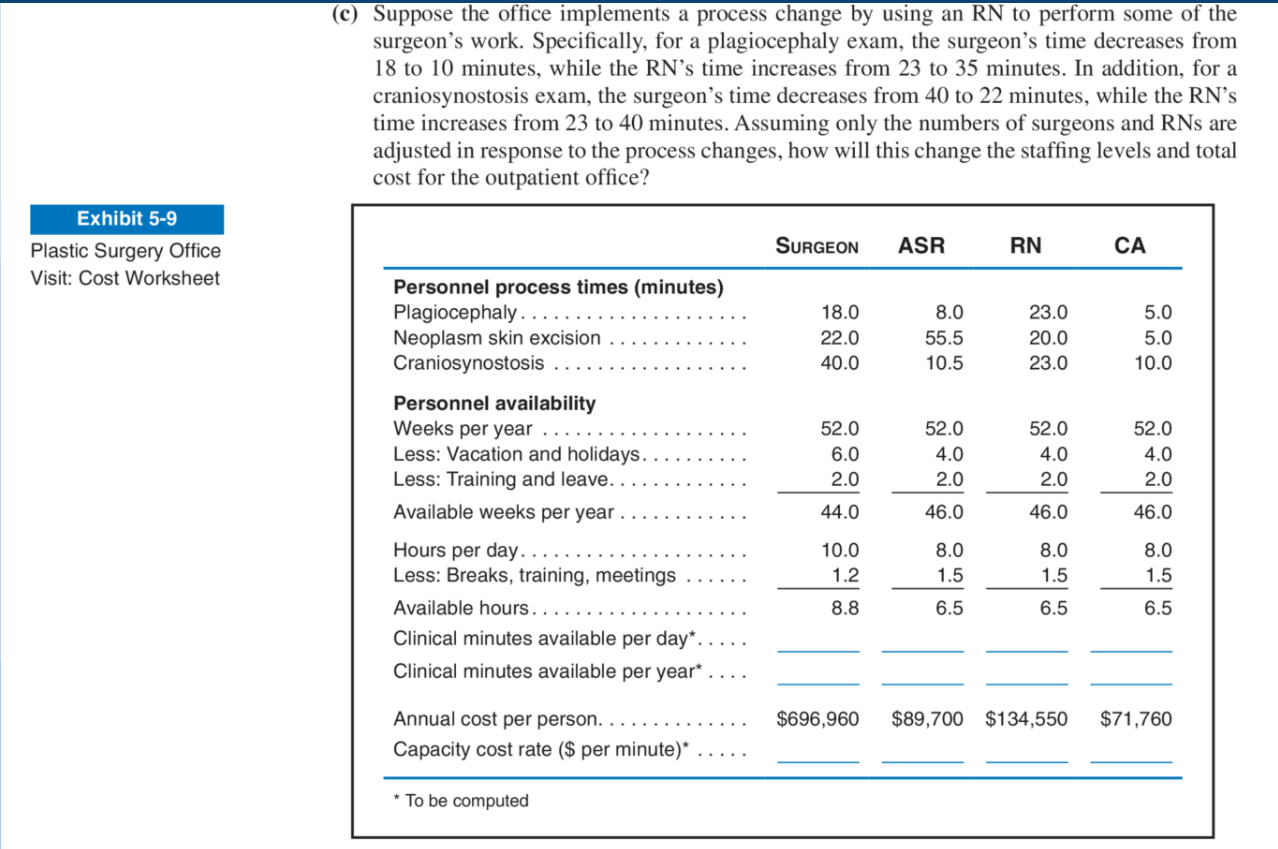

product costs. 5-38 TDABC, outpatient office Consider three types of office visits to a pediatric plastic surgery (L01, 2, 3, 4, 5, 6) office, representing a range of potential patient care needs: primary care, simple surgery, and complex surgery. 1. Deformational plagiocephaly is a common disorder characterized by a flattening of the head or face, typically caused by placing an infant in the same position (e.g., on the infant's back) for long periods of time 2. Benign neoplasms of the skin are harmless cutaneous growths that include common skin lesions, such as skin cysts, benign skin tumors, and congenital nevi (moles). 3. Craniosynostosis is a deformity that arises when one or more sutures (the fibrous connec- tions that separate the bones of an infant's skull) fuse earlier than normal. This is a serious condition that requires surgery to avoid developmental delays and cognitive impairment. The initial office visit for all three conditions is coded by the Centers for Medicare and Medicaid Services system as a "level-3 visit" and carries an identical charge of $350. The surgery office's practice uses a ratio-of-costs-to-charges (RCC) system to assign costs to individual visits and procedures. The RCC system works by dividing total annual departmental costs by the sum of all the charges billed for patient visits and procedures during the year. The cost for any proce- dure is calculated by multiplying the RCC ratio by the charge for that procedure. In 2019, the total charges for all plastic surgeon patient encounters were $12,449,500. Because of discounts nego tiated with its payers, primarily the patients' private health plans, actual cash receipts to the prac- tice were $7.967,680. Total clinical and administrative costs for the department were $7,469,700. A TDABC project team estimated the time required for the four types of personnel involved in office visits for the three conditions: surgeon, ambulatory service representative (ASR), reg. istered nurse (RN), and a clinical assistant (CA). For the costing component, the team estimated each personnel's capacity cost rate by dividing the individual's annual compensation and support costs by the total number of minutes per year that the person was available to work with patients. The team then interviewed clinical and administrative personnel to estimate their availability (practical capacity) for performing patient-related work. The team obtained the following data: 1. Surgeons had 4 weeks of vacation, plus 10 holiday days and another 10 days for professional conferences and training. 2. Surgeons generally worked 5 days per week and 10 hours per day. About 1.2 hours (72 min- utes) were taken up with nonclinical meetings and breaks. 3. Nonphysician personnel had 2 weeks of vacation, 10 holiday days, 5 days for sick and per- sonal leave, and training days. 4. Nonphysician personnel worked 5 days per week and 8 hours per day, with an average of 1.5 hours per day used for breaks and training. The team then collected data on office expenses and the compensation of the department's clinical and administrative personnel (see Exhibit 5-9). The team was now ready to calculate accurate costs and profit margins for the three types of office visits. Required (a) Calculate the costs and profits of the three different office visits using two methods: 1. RCC method 2. TDABC method Why do the two methods produce such different cost estimates? (b) The office currently has the following full-time equivalents (FTEs): 1.5 surgeons, 2 ASR, 2RNs, and I CA. Suppose that in the following year, the office will have 5,400 plagiocephaly visits, 2,000 neoplasm visits, and 800 craniosynostosis visits. 1. How many FTEs of each staff type will the practice need to handle this volume and mix of patient visits? 2. Using the capacity cost rates you developed in part 2 of requirement (a), what is the total TDABC of this new staffing level? 3. What is the quantity of the unused capacity with your staffing recommendation? (C) Suppose the office implements a process change by using an RN to perform some of the surgeon's work. Specifically, for a plagiocephaly exam, the surgeon's time decreases from 18 to 10 minutes, while the RN's time increases from 23 to 35 minutes. In addition, for a craniosynostosis exam, the surgeon's time decreases from 40 to 22 minutes, while the RN's time increases from 23 to 40 minutes. Assuming only the numbers of surgeons and RNs are adjusted in response to the process changes, how will this change the staffing levels and total cost for the outpatient office? Exhibit 5-9 Plastic Surgery Office Visit: Cost Worksheet SURGEON ASR RN CA 8.0 Personnel process times (minutes) Plagiocephaly.. Neoplasm skin excision Craniosynostosis 18.0 22.0 40.0 55.5 10.5 23.0 20.0 23.0 5.0 5.0 10.0 Personnel availability Weeks per year. Less: Vacation and holidays. Less: Training and leave. Available weeks per year 52.0 6.0 2.0 52.0 4.0 2.0 52.0 4.0 2.0 52.0 4.0 2.0 44.0 46.0 46.0 46.0 10.0 1.2 8.0 1.5 8.0 1.5 8.0 1.5 Hours per day... Less: Breaks, training, meetings Available hours.. Clinical minutes available per day* Clinical minutes available per year* 8.8 6.5 6.5 6.5 $696,960 $89,700 $134,550 $71,760 Annual cost per person.. Capacity cost rate ($ per minute)* * To be computed product costs. 5-38 TDABC, outpatient office Consider three types of office visits to a pediatric plastic surgery (L01, 2, 3, 4, 5, 6) office, representing a range of potential patient care needs: primary care, simple surgery, and complex surgery. 1. Deformational plagiocephaly is a common disorder characterized by a flattening of the head or face, typically caused by placing an infant in the same position (e.g., on the infant's back) for long periods of time 2. Benign neoplasms of the skin are harmless cutaneous growths that include common skin lesions, such as skin cysts, benign skin tumors, and congenital nevi (moles). 3. Craniosynostosis is a deformity that arises when one or more sutures (the fibrous connec- tions that separate the bones of an infant's skull) fuse earlier than normal. This is a serious condition that requires surgery to avoid developmental delays and cognitive impairment. The initial office visit for all three conditions is coded by the Centers for Medicare and Medicaid Services system as a "level-3 visit" and carries an identical charge of $350. The surgery office's practice uses a ratio-of-costs-to-charges (RCC) system to assign costs to individual visits and procedures. The RCC system works by dividing total annual departmental costs by the sum of all the charges billed for patient visits and procedures during the year. The cost for any proce- dure is calculated by multiplying the RCC ratio by the charge for that procedure. In 2019, the total charges for all plastic surgeon patient encounters were $12,449,500. Because of discounts nego tiated with its payers, primarily the patients' private health plans, actual cash receipts to the prac- tice were $7.967,680. Total clinical and administrative costs for the department were $7,469,700. A TDABC project team estimated the time required for the four types of personnel involved in office visits for the three conditions: surgeon, ambulatory service representative (ASR), reg. istered nurse (RN), and a clinical assistant (CA). For the costing component, the team estimated each personnel's capacity cost rate by dividing the individual's annual compensation and support costs by the total number of minutes per year that the person was available to work with patients. The team then interviewed clinical and administrative personnel to estimate their availability (practical capacity) for performing patient-related work. The team obtained the following data: 1. Surgeons had 4 weeks of vacation, plus 10 holiday days and another 10 days for professional conferences and training. 2. Surgeons generally worked 5 days per week and 10 hours per day. About 1.2 hours (72 min- utes) were taken up with nonclinical meetings and breaks. 3. Nonphysician personnel had 2 weeks of vacation, 10 holiday days, 5 days for sick and per- sonal leave, and training days. 4. Nonphysician personnel worked 5 days per week and 8 hours per day, with an average of 1.5 hours per day used for breaks and training. The team then collected data on office expenses and the compensation of the department's clinical and administrative personnel (see Exhibit 5-9). The team was now ready to calculate accurate costs and profit margins for the three types of office visits. Required (a) Calculate the costs and profits of the three different office visits using two methods: 1. RCC method 2. TDABC method Why do the two methods produce such different cost estimates? (b) The office currently has the following full-time equivalents (FTEs): 1.5 surgeons, 2 ASR, 2RNs, and I CA. Suppose that in the following year, the office will have 5,400 plagiocephaly visits, 2,000 neoplasm visits, and 800 craniosynostosis visits. 1. How many FTEs of each staff type will the practice need to handle this volume and mix of patient visits? 2. Using the capacity cost rates you developed in part 2 of requirement (a), what is the total TDABC of this new staffing level? 3. What is the quantity of the unused capacity with your staffing recommendation? (C) Suppose the office implements a process change by using an RN to perform some of the surgeon's work. Specifically, for a plagiocephaly exam, the surgeon's time decreases from 18 to 10 minutes, while the RN's time increases from 23 to 35 minutes. In addition, for a craniosynostosis exam, the surgeon's time decreases from 40 to 22 minutes, while the RN's time increases from 23 to 40 minutes. Assuming only the numbers of surgeons and RNs are adjusted in response to the process changes, how will this change the staffing levels and total cost for the outpatient office? Exhibit 5-9 Plastic Surgery Office Visit: Cost Worksheet SURGEON ASR RN CA 8.0 Personnel process times (minutes) Plagiocephaly.. Neoplasm skin excision Craniosynostosis 18.0 22.0 40.0 55.5 10.5 23.0 20.0 23.0 5.0 5.0 10.0 Personnel availability Weeks per year. Less: Vacation and holidays. Less: Training and leave. Available weeks per year 52.0 6.0 2.0 52.0 4.0 2.0 52.0 4.0 2.0 52.0 4.0 2.0 44.0 46.0 46.0 46.0 10.0 1.2 8.0 1.5 8.0 1.5 8.0 1.5 Hours per day... Less: Breaks, training, meetings Available hours.. Clinical minutes available per day* Clinical minutes available per year* 8.8 6.5 6.5 6.5 $696,960 $89,700 $134,550 $71,760 Annual cost per person.. Capacity cost rate ($ per minute)* * To be computed








